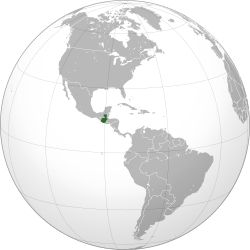Guatemala: Army Kills Seven Indigenous Protestors In Totonicapán
By Louisa Reynolds
After electricity costs in the northwestern department of Totonicapán doubled in under a year to almost US$12 a month, Mayan Kiché community leader Juana Celestina Batz Puac decided to protest. “It’s too much,” she said, shaking her head.
To Batz Puac, it’s unfair that rural families that have one light bulb at home should be subjected to a seemingly arbitrary price hike. “They need to listen to our demands…As indigenous people, we’re using their energy and they’re getting rich at the expense of the people,” she said.

Totonicapán’s 48 cantons are particularly angry because street lighting doesn’t reach rural areas even though they are charged for this on their monthly bill. In May, protestors occupied the office of Energuate, an energy distributor, in the departmental capital, also named Totonicapán. However, the company — which is majority owned by British private investment firm Actis — insisted it only charges what the government’s National Electric Commission stipulates it can. Protestors’ demands went unheeded.
Totonicapán is one of Guatemala’s poorest departments (82.2 percent of its population suffers from chronic malnutrition, according to the Secretariat for Food Security and Nutrition). However, collective action runs in its history. In 1998 and 2002, its 48 cantons took to the streets to protest tax hikes and in 2007, they prevented a controversial bill that would have privatized water services from being passed in Congress.
With that background, indigenous leaders from the department erected two blockades on the Inter-American Highway on Oct. 4 at Cumbre de Alaska (kilometer 170) and a busy junction known as Cuatro Caminos (kilometer 188).
The day before, indigenous leaders announced their intention to block the highway and police officers wearing riot gear arrived early that morning. While the blockade took place, Totonicapán’s 48 cantonal leaders arrived at the presidential palace at around 2 pm. They were, however, denied entry and told that President Otto Pérez Molina, a hard-line retired army general, would not see them.
Different versions
Dozens of police vehicles and at least two army vehicles were sent to the Inter-American Highway. What happened next is currently under investigation by the Attorney General’s Office as different versions of events have emerged.
According to Interior Minister Mauricio López Bonilla, when protestors refused to clear the area, police used tear gas to disperse the crowd and the army was sent in to help. However, López Bonilla claimed the soldiers were unarmed and most of the casualties were from shotgun and machete wounds inflicted during a scuffle among protestors. Seven people were killed in the ensuing chaos, he said, and protestors had also pelted police with stones and torched several army and police vehicles. López Bonilla added that freedom of movement had to be defended and respected above all else.
Dozens of civilians suffered teargas poisoning. Ultimately, 34 were injured and seven died: Santos Nicolás Hernández, Jesús Francisco Puac, Arturo Félix Fapón, Eusebio José Puac, Jesús Cano, Santos Nicolás Menchú and Rafael Batz, all from the department of Totonicapán.
The protestors’ side of the story is very different. “Those who attended the blockade say that the army opened fire on them,” said indigenous leader Carmen Tacam during a press conference. She also stressed that the protestors were unarmed and explained that some were carrying the “wand of community authority” (a wooden stick handed to the community’s leader during a traditional Mayan ceremony when he or she is elected).
Guatelamala’s Human Rights Ombudsman’s Office also reported that, contrary to what López Bonilla said, the soldiers sent to help police to disperse the crowd were armed with Israeli-manufactured Galil rifles used by the armed forces during Guatemala’s 36-year civil war.
The government also claimed that civilian-clad agitators infiltrated the protest and opened fire on police, who then retaliated. This has been vehemently denied by protestors.
The United Nations and the diplomatic corps have strongly condemned the government’s actions during the protest. “It’s regrettable that a legitimate demonstration should leave seven people dead. Asking the army to intervene in civilian security tasks is too high a risk,” said Alberto Brunori, of the UN Office of the High Commissioner for Human Rights, or OHCHR.
Anger over foreign minister’s remarks
On Oct. 5, local shops throughout Totonicapán closed as a sign of mourning for the protestors killed. People took to the streets in the departmental capital’s main square, bearing placards that called for justice and an end to repressive government policies. Nobel Peace Laureate Rigoberta Menchú travelled to the area on a fact-finding mission on behalf of her human rights organization, the Rigoberta Menchú Foundation.
While Totonicapán was still grieving, sadness turned to wrath when Foreign Minister Harold Caballeros tried to lessen the gravity of the incident by saying that many more people die each day as a result of increased violence. “Every day we have twice as many murders in this country so it’s really not such a big deal,” Caballeros said.
He then used his Twitter account to refer to his critics as “burros” and “pendejos” (ignorant and stupid people). He later apologized and said that the remarks were made in the heat of anger. However, Menchú and other indigenous leaders responded by labeling Caballeros “a racist” and demanding his immediate resignation. President Pérez Molina stated that a government official “cannot afford to talk to people in such a manner.”
The National Unity of Hope Party, or UNE, and Menchú’s Winaq party have summoned Caballeros to Congress so that he can be held accountable over the incident and strongly admonished for his actions. However, in order to force his removal, these two parties would have to launch a formal congressional inquiry and secure a majority vote in Congress, which is unlikely given that the official Patriot Party holds more than half the legislature’s seats.
